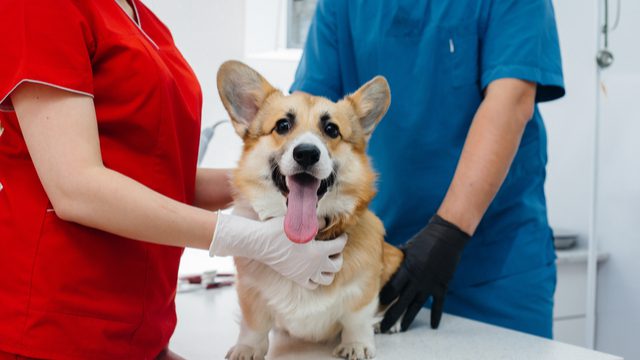The anatomy of the dog is quite complex and requires the guidance of a veterinarian. Although, most people describe the anatomy of dogs to be similar to human beings. Nevertheless, some differences are worth noting, especially the nerves.
The nerves in a dog’s body are a vast and complex network. The sciatic nerves play an essential role in the nervous system of dogs during movement. The sciatic nerve is found in the lumbar region near the hip, and it is one of the longest and thickest bones.
What is Sciatica in Dogs?

Sciatica can be defined as an abnormal health condition in dogs that is usually accompanied by discomfort or distress in the lumbar region of the dog. The cause of the pain is because of several damages to the sciatic or ischiatic nerve.
The sciatic nerve is made up of two nerves, the lateral and the medial nerves. After forming in the pelvic region, it moves towards the back of the lower limb, passing between the gluteal region’s superficial and deep muscle groups. When the sciatic nerve gets damaged, it’s usually associated with pains in the dog’s leg.
Causes of Sciatica in Dogs
According to specialists, there are seven leading causes of Sciatica in dogs, and they are as follows;
Canine Herniated Disc
Herniated discs are a leading cause of Sciatica in humans and dogs. Dogs that are having spine issues are mostly affected by this pathology. When the ring of disc cracks, the fibrous nucleus is forced out of its location and can sometimes compress the spinal cord or the sciatic nerve.
Lumbosacral Stenosis
Cauda equina syndrome corresponds to all forms of nerve compression or their degeneration in the lumbosacral vertebrae and the sacrum. This problem often occurs between the L7, S1 vertebra and can become very painful to dog.
The shock of the Rear Axle
Hip or pelvic fracture due to a collision with a car or a fall can cause multiple injuries for a dog and sometimes death. The sciatic nerve passes very close to the hip and pelvic joints (ilium, ischium, and acetabulum). It can therefore be injured in the event of a violent physical impact of the rear axle.
Genetic Factor
Studies had shown that intervertebral dislocation could also be transmitted via family lines. This mutation is believed to have a destructive action through a constituent protein known as collagen alpha-1(IX). The genetic disorder is believed to cause weakness of the bone as well as other related bone issues.
Old age
Over the years, the structures of dogs’ spines degenerate, thereby causing more pains frequently.
Sedentary life
Sedentary life causes a reduction in abdominal muscle tone and consequently can lead to the appearance of low back pain and Sciatica.
Late-stage pregnancy

During pregnancy, the mobility of the pelvis and sacrum increases significantly. This increased mobility and the weight of the uterus and fetus can strain the back and give Sciatica.
Types of Sciatic Nerve damage in dogs
Although there are different causes of Sciatica in dogs can be classified into three levels of severity;
Neurapraxia
Neurapraxia refers to the less severe case of sciatic injury. Damage to the nerve roots causes mild symptoms that are reversible with proper treatment.
Axonotmesis
Axonotmesis is the second class of sciatic nerve injury; the dog can partially destroy its axon while the surrounding connective tissue remains intact. He may suffer from a lack of motor skills in the hind limbs and an inability to stretch the hindquarters. Muscle wasting is a prevalent sign of axonotmesis.
Neurotmesis
Neurotmesis in the form of the lesion is the worst form of Sciatica. It is often irreversible and results from the destruction of nerve cells and connective tissue from one or both sciatic nerves.
Sciatica Symptoms in Dogs
Symptoms of Sciatica vary depending on two major factors, such as the location of the compression and the stages of evolution of the hernia. The more severe a sciatic nerve, the more the spinal cord is compressed. Scientists have shown that there are five clinical stages or symptoms of Sciatica in dogs;
Stage 1: The dog feels pain that he can manifest by prostration, aggression during specific movements. The dog can walk but is reluctant to go up or down the stairs.
Stage 2: The dog moves with difficulty with a drunken gait, as if he were drunk.
Stage 3: The dog is partially paralyzed, he can no longer walk independently, but he can still control the emission of his urine and his stools.
Stage 4: The animal is paralyzed and incontinent. At this point, he still feels pain.
Stage 5: The animal is paralyzed, incontinent, and has lost sensitivity to deep pain.
You can pay more attention to the way your dog moves. The best time to observe it would be during physical activity. The nerve compression will cause pain and partial or total loss of control of the hind legs.
How to Treat Sciatica in Dogs
The treatment may vary depending on various factors of the pathology. However, always seek the advice of a veterinarian and don’t make any independent decisions.
Anti-inflammatory drugs

On prescription from your veterinarian, they will help your pet manage pain. This treatment cannot be given for too long because of the risk of addiction and side effects.
Appropriate food and food supplements
The implementation of a suitable diet is essential. Your veterinarian will direct you to some specific diets for your canine. These diets are richer in chondroitin and have a particular supply of vitamins. They help protect your animal’s cartilages and fight against Sciatica.
Surgical intervention
Surgical interventions may be offered to you depending on the stage of development, the state of health, and your companion’s age. For Sciatica, the procedure involves lifting the compression of the sciatic nerve. During a herniated disc surgery, the surgeon will have to remove what deforms the marrow.
The degree of deformity of the marrow and the condition of the marrow itself determine factors in the success of the surgery. In total paralysis, the dog must be operated on within 48 hours to have a real chance of regaining his mobility.
Alternative medicine
Physiotherapy and osteopathy are known to bring good results to an animal. Used in addition to conventional treatments, they help to repel the worsening of symptoms. These methods make it possible to postpone or even avoid the surgical response when the dog’s state of health is not too degraded.
How do you choose Alternative treatments for Sciatica?
All these practices require skilled professionals to be applied effectively and correctly. Listed below are some tips for choosing the best.
- Listen to your vet: he may know professionals who have achieved good results and can be trusted.
- Find out what the treatment means: Find out the cost of the commitment required and evaluate if you can deal with it. Also, assess how many sessions are needed, the facility’s location (near or far), etc.
- Evaluate the qualification of the veterinarian: Evaluate the certification of who is supposed to carry out the sessions, their certificate, and experiences.
How is Sciatica diagnosed?
The diagnosis of Sciatica is as follows;
- Clinic: A simple visit to the veterinarian clinic can assist in diagnosing Sciatica in dogs.
- Dorsal-lumbar and lumbosacral spine x-ray: It helps highlight the disc space, thereby suggesting the presence of hernia or spondylolisthesis
- Magnetic Resonance (MRI) of the spine: It evaluates the presence of disc herniation, primary or metastatic spinal tumors, spondylodiscitis (inflammation of the intervertebral discs and vertebrae)
- Lumbar spine CT: performed in case of suspected fractures
- Electromyography (EMG): It is carried out to accentuate the suffering of the nerve root.
Cost of Treatment

To treat Sciatica, the cost varies depending on the veterinarian expert and the individual health insurance cover. However, the average price for treating sciatic nerves is about $500 for the surgery. While for the anti-inflammatory drugs, it can cost about $15 – $30 per drug. The use of anti-inflammatory drug cost much on the long run, and it may present some side effects.
Sciatica Treatment
The management of sciatic nerves in dogs and chronic joint pain is an important challenge for dog owners and veterinarians. Below are some of the sciatica treatment procedures;
- Recognize The Problem:
One of the most effective remedies for sciatic nerve pain is early detection of the problem. Understanding and recognizing the symptoms is the first big step. For example, if your dog walks with the hind leg raised, it may be the presence of sciatic nerve compression.
- Body Weight Assessment:
This may seem strange, but weight reduction is a clear sign of sciatic nerve disorder. Pain from the back can cause your dog to lack an appetite for food.
- Environmental Measures:
A dog with sciatic nerve has walking difficulties. Helping him move around the house with more excellent safety and stability means giving him relief. Here are some of the actions to carry out:
- Use carpets and runners on stairs and floors (indoors) to prevent them from slipping.
- Check that the bed is comfortable and warm, especially in winter, because the cold worsens the pain.
- Ensure that there is no hindrance to the movement of the dog.
- Surgery :
Depending on the advance and the condition’s cause, your veterinarian may consider performing a surgical operation. For a wholly paralyzed nerve, surgery is required to relocate the muscles that compress the nerve fibers. Remember that the surgery does not have a success rate of 100% and may not always provide satisfactory results.
- Braces:
After the surgery, if your dog is limping, the best method to reduce the pain and avoid further injury aggravation is to wear your dog a brace. They are aids that support the limb during movement, immobilizing the inflamed part or supporting a joint, especially in animals of a certain age.
The brace should be used according to the veterinarian’s instructions, and the type depends on the problem. Ensure you choose the right size of brace, which should neither be tight nor slip off.
- Physical Therapy
Physical therapy includes physiotherapy, acupuncture, or even osteopathy. It can bring many benefits to the comfort of your dog’s life, mainly to prevent Sciatica and for better postoperative rehabilitation.
However, it must complement the treatment already present and not replace it. The veterinarian must also be informed to give his opinion and direct you to the best therapy.
Exercises for Sciatica in Dogs
Dogs love to play and run at the sight of a ball or a chase which could be too strong even in joint pain. Therefore, observe the dog’s movement and don’t be fooled by any enthusiasm.
If your dog loves running, consider not letting him do it too much, but limit the speed and intensity with a leash. Replace or introduce mental activation exercises (look for the ball, rather than chase it, for example) to make it vent more and better.
Natural Remedies for Sciatica
In addition to classic physiotherapy and other alternative treatments, natural remedies effectively combat Sciatica in dogs. The following are some of the natural remedies:
- Ginger: This is a plant of great power and anti-inflammatory painkiller. A straightforward method against Sciatica is by applying the oil or fluid from the plant material directly to the skin’s surface.
- Turmeric: This is another powerful spice with great inflammatory power and alleviating the symptoms of Sciatica. It also has a solid antioxidant action which makes it ideal for counteracting the action of free radicals.
- Hot or cold press: You can wrap some quantity of ice and apply it to the affected region of your dog. Also, you can use to press the affected area with damp clothing or hot water.
- MSM: Methyl sulfonyl methane is the organic form of sulfur, an essential mineral for the health of bones and muscles, and which has anti-inflammatory action. MSM is mainly used to relieve pain but also to improve joint health. The antioxidant activity helps to reduce bone and muscle pain, helping to prevent degeneration in these tissues.
- Devil’s claw: This anti-inflammatory plant par excellence is helpful for musculoskeletal pains. Rich in harpagosides, one of the phytocomplex substances found in the root, has a natural analgesic effect. It can be used for diseases affecting muscles, tendons, and bones, helping relieve inflammation and relieve pain.
Sciatica Prevention in Dogs
Prevention is essential for many dog health problems. The methods of preventing back pain, in particular, are also helpful in avoiding the appearance of other health problems such as Sciatica.
From an early age, it is essential to prevent the dog from playing too violently, jumping too high, and moving on slippery floors and stairs that are too steep. Finally, just as it also happens for humans, the good health of the sciatic nerve of dogs depends on the diet and a well-trained musculature. That is excellent stretching and another sporting exercise to keep in the musculature of the dog.
Conclusion
In conclusion, Sciatica is characterized by the presence of pain in the lower back, buttock level, and along the leg or foot of your dog. The pain can be of different intensity and persistence depending on the triggering cause. As surprising as it may seem dog which is considered lower-order also suffer from Sciatica.
This may even limit their movement as well cause tremendous pain when urinating. Therefore, a closer look at the subject will help transmit the proper knowledge to adopt towards your pet.


